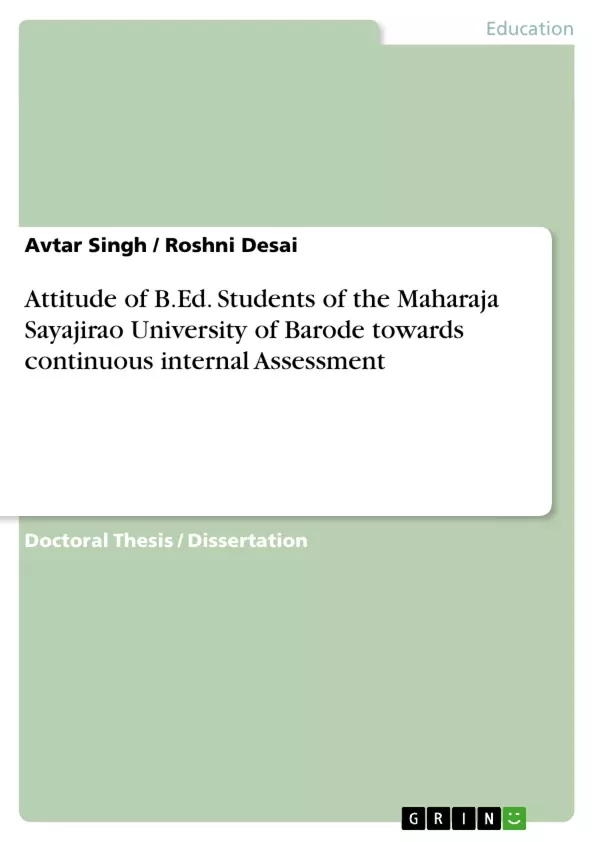Continuous Comprehensive Evaluation (CCE) is the buzz word being in the air since the talks of the examination reforms being given utmost importance as far as the Indian education system is concerned. As rightly quoted by University Education Commission (1948-49) that, “If we are to suggest a single reform in the system of education then it would be that of examination”. The remark was followed by formation of number of committees and commissions with different recommendations for the evaluation system for the Indian education system. All intelligentsia converged to the CCE as an assessment tool for wholistic evaluation of the students’ learning. Further with internal examination this component cease to happen in the way it is suppose to be. Students being the internal and indispensible part of the education system had to undergo such system. How they perceive this component? Further how teachers perceive this continuous internal assessment system who are going to use the same as ‘would be teachers’ in the future? The Faculty of Education and Psychology, The Maharaja Sayajirao University of Baroda, has adopted the continuous internal assessment system since 1967-68 i.e. from last four decades. The students of the Bachelor of Education (B.Ed.) program are party to this system and in future, as teachers may be involved in the system. How do they perceive the system? , What is their attitude towards the system? would decide the future course of the system. Moreover, these students may have come from different institutes/faculties with different evaluation patterns, how that influence their attitude?, which other factors can have an impact on attitude towards continuous internal assessment. How do student perceive the evaluation system of Department of Education, MSU? What are the issues and liking of the student towards the evaluation system of Department of Education, MSU? Can we say anything firmly about the attitude of the students towards the system of continuous internal assessment? Can we say anything about the impact of different variables like Gender, Caste, Habitat, Age, Marital Status, Previous system of Education, Stream etc on attitude towards continuous internal assessment? The study attempts to answer the aforesaid questions.
Inhaltsverzeichnis (Table of Contents)
- CHAPTER I: CONCEPTUAL FRAMEWORK
- Introduction
- Measurement, Assessment and Evaluation
- Present Examination System and Its Impact
- Different Aspects of Assessment
- Continuous Assessment
- Internal Assessment
- Continuous Internal Assessment
- Characteristics of Continuous Internal Assessment
- Advantages of the Continuous Internal Assessment
- Short Comings
- Semester System
- Present Status of Continuous Internal Assessment
- Evaluation Scheme in The Maharaja Sayajirao University of Baroda
- Evaluation Scheme in Faculty of Education and Psychology
- Evaluation Scheme at B.Ed. Level
- Attitude
- Characteristics of Attitudes
- Attitude towards Continuous Internal Assessment
- CHAPTER II: REVIEW OF RELATED LITERATURE
- Introduction
- Abstracts of the Studies Reviewed
- Observation and Implication for the present study
- CHAPTER III: METHODOLOGY OF THE STUDY
- Introduction
- Rationale
- Title of the Study
- Objectives of the Study
- Hypotheses
- Explanation of the Term
- Operationalization of the Term
- Methodology of the Study
- Design of the Study
- Population of the Study
- Sample of the Study
- Characteristics of the Sample
- Tools for the Study
- Personal Information Schedule
- Tools to measure Attitude towards Continuous Internal Assessment
- Data Collection
- Data Analysis
- CHAPTER IV: DATA ANALYSIS AND INTERPRETATION
- Introduction
- Analysis of the Attitude Scale
- Distribution of Attitude towards Continuous Internal Assessment
- Section I: Analysis from the Attitude Scale
- Section II: Content Analysis of the Open-ended Questions
- Analysis of Question 1
- Analysis of Question 2
- Analysis of Question 3
- Attitude towards Continuous Internal Assessment with respect to Selected Variables
Zielsetzung und Themenschwerpunkte (Objectives and Key Themes)
This research aims to explore the attitude of B.Ed. students at the Maharaja Sayajirao University of Baroda towards Continuous Internal Assessment (CIA). The study delves into the characteristics and advantages of CIA while examining its shortcomings. It also analyzes the present evaluation scheme within the university and the Faculty of Education and Psychology, particularly at the B.Ed. level.
- The role and impact of the current examination system on student learning.
- The understanding and perceptions of B.Ed. students regarding CIA.
- An analysis of the advantages, disadvantages, and characteristics of CIA.
- An exploration of the implementation and effectiveness of CIA at the Maharaja Sayajirao University of Baroda.
- The identification of factors influencing student attitudes towards CIA.
Zusammenfassung der Kapitel (Chapter Summaries)
Chapter I, "Conceptual Framework," establishes the foundation for the research by defining key terms like assessment, evaluation, and continuous internal assessment. It explores the current examination system, its strengths and weaknesses, and the various aspects of assessment. Chapter II, "Review of Related Literature," examines previous studies on CIA, identifying trends, methodologies, and findings relevant to the current research. Chapter III, "Methodology of the Study," details the research design, population, sample, tools, and data collection and analysis methods. Chapter IV, "Data Analysis and Interpretation," presents the analysis of the collected data, focusing on student attitudes towards CIA and examining the relationship between these attitudes and selected variables.
Schlüsselwörter (Keywords)
The research explores the attitudes of B.Ed. students towards Continuous Internal Assessment (CIA) within the Maharaja Sayajirao University of Baroda. Key terms and themes include assessment, evaluation, examination system, student learning, attitude, and the impact of CIA on student learning. The study utilizes a survey approach to analyze student responses and provide insights into the effectiveness and perceived value of CIA.
- Arbeit zitieren
- Avtar Singh (Autor:in), Roshni Desai (Autor:in), 2013, Attitude of B.Ed. Students of the Maharaja Sayajirao University of Barode towards continuous internal Assessment, München, GRIN Verlag, https://www.grin.com/document/209084



